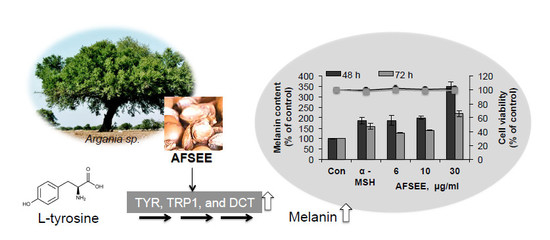Argania Spinosa Fruit Shell Extract-Induced Melanogenesis via cAMP Signaling Pathway Activation
Abstract
1. Introduction
2. Results
2.1. AFSEE Has No Cytotoxic Effect on B16F10 Cells
2.2. AFSEE Enhances Melanogenesis in B16F10 Cells
2.3. Melanogenic Enzymes Expression Level in B16 Melanoma Cells
2.4. AFSEE Inhibited MITF Phosphorylation in B16F10 Cells
2.5. Influence of AFSEE on ERK and p38 Mitogen-Activated Protein Kinases in B16F10 Cells
2.6. AFSEE Upregulated Tyr, Trp1, and Dct Gene Expression
2.7. AFSEE Upregulated Mitf Expression
2.8. Transcriptome Changes Induced by AFSEE in B16F10 Cells
2.9. Validation of DNA Microarray Results by Real-Time PCR
2.10. Phytochemical Characterization of AFSEE
3. Discussion
4. Materials and Methods
4.1. Reagents
4.2. Preparation of Argan Fruit Shell Extract
4.3. AFSEE Chemical Characterization
4.4. Cell Culture
4.5. Cell Proliferation
4.6. Melanin Quantification
4.7. Western Blot
4.8. Real-Time PCR
4.9. DNA Microarray Analysis
4.10. Statistical Analysis
5. Conclusions
Supplementary Materials
Author Contributions
Funding
Acknowledgments
Conflicts of Interest
Abbreviations
| AFSEE | Argan fruit shell ethanol extract |
| Akap13 | A-kinase anchor protein 13 |
| cAMP | Cyclic adenosine monophosphate |
| CREB | cAMP-responsive element binding protein |
| Crebbp | CREB binding protein |
| Cxcl10 | C–X–C motif chemokine ligand 10 |
| DCT | Dopachrome tautomerase |
| ERK | Extracellular signal-regulated kinase |
| GAPDH | Glyceraldehyde 3-phosphate dehydrogenase |
| HPLC | High-performance liquid chromatography |
| Lef1 | Lymphoid enhancer binding factor 1 |
| MAPK | Mitogen-activated protein kinase |
| MITF | Microphthalmia-associated transcription factor |
| MTT | 3-(4,5-dimethylthiazolyl-2)-2,5-diphenyltetrazolium bromide |
| Pax3 | Paired box gene 3 |
| PBS | Phosphate-buffered saline |
| PKA | Protein kinase A |
| RT-PCR | Real-time polymerase chain reaction |
| Sox 10 | SRY-box containing gene 10 |
| TRP1 | Tyrosinase-related protein 1 |
| TYR | Tyrosinase |
| α-MSH | alpha-melanocyte-stimulating hormone |
| α-MSH | alpha-melanocyte-stimulating hormone |
References
- Campos, P.M.; Horinouchi, C.D.D.S.; Prudente, A.D.S.; Cechinel-Filho, V.; Cabrini, D.D.A.; Otuki, M.F. Effect of a Garcinia gardneriana (Planchon and Triana) Zappi hydroalcoholic extract on melanogenesis in B16F10 melanoma cells. J. Ethnopharmacol. 2013, 148, 199–204. [Google Scholar] [CrossRef] [PubMed]
- Ito, S. IFPCS presidential lecture: A chemist’s view of melanogenesis. Pigment Cell Res. 2003, 16, 230–236. [Google Scholar] [CrossRef] [PubMed]
- D’Mello, S.A.N.; Finlay, G.J.; Baguley, B.C.; Askarian-Amiri, M.E. Signaling pathways in melanogenesis. Int. J. Mol. Sci. 2016, 17, 1144. [Google Scholar] [CrossRef] [PubMed]
- Cardinaux, J.R.; Notis, J.C.; Zhang, Q.; Vo, N.; Craig, J.C.; Fass, D.M.; Brennan, R.G.; Goodman, R.H. Recruitment of CREB binding protein is sufficient for CREB-mediated gene activation. Mol. Cell Biol. 2000, 20, 1546–1552. [Google Scholar] [CrossRef]
- Villareal, M.O.; Kume, S.; Bourhim, T.; Bakhtaoui, F.Z.; Kashiwagi, K.; Han, J.; Gadhi, C.; Isoda, H. Activation of MITF by argan oil leads to the inhibition of the tyrosinase and dopachrome tautomerase expressions in B16 murine melanoma cells. Evid. Based Complement. Alternat. Med. 2013, 2013, 340107. [Google Scholar] [CrossRef]
- Bourhim, T.; Villareal, M.O.; Gadhi, C.; Hafidi, A.; Isoda, H. Depigmenting effect of argan press-cake extract through the down-regulation of Mitf and melanogenic enzymes expression in B16 murine melanoma cells. Cytotechnology 2018, 70, 1389–1397. [Google Scholar] [CrossRef]
- El Monfalouti, H.; Charrouf, Z.; Belviso, S.; Ghirardello, D.; Scursatone, B.; Guillaume, D.; Denhez, C.; Zeppa, G. Analysis and antioxidant capacity of the phenolic compounds from argan fruit (Argania spinosa (L.) Skeels). Eur. J. LipidSci. Tech. 2012, 114, 446–452. [Google Scholar] [CrossRef]
- Jung, E.; Lee, J.; Huh, S.; Lee, J.; Kim, Y.S.; Kim, G.; Park, D. Phloridzin-induced melanogenesis is mediated by the cAMP signaling pathway. Food Chem. Toxicol. 2009, 47, 2436–2440. [Google Scholar] [CrossRef]
- Ko, H.H.; Chiang, Y.C.; Tsai, M.H.; Liang, C.J.; Hsu, L.F.; Li, S.Y.; Wang, M.C.; Yen, F.L.; Lee, C.W. Eupafolin, a skin whitening flavonoid isolated from Phyla nodiflora, downregulated melanogenesis: Role of MAPK and Akt pathways. J. Ethnopharmacol. 2014, 151, 386–393. [Google Scholar] [CrossRef]
- Bu, J.; Ma, P.C.; Chen, Z.Q.; Zhou, W.Q.; Fu, Y.J.; Li, L.J.; Li, C.R. Inhibition of MITF and tyrosinase by paeonol-stimulated JNK/SAPK to reduction of phosphorylated CREB. Am. J. Chin. Med. 2008, 36, 245–263. [Google Scholar] [CrossRef]
- Kadekaro, A.L.; Kanto, H.; Kavanagh, R.; Abdel-Malek, Z.A. Significance of the melanocortin 1 receptor in regulating human melanocyte pigmentation, proliferation, and survival. Ann. N. Y. Acad. Sci. 2003, 994, 359–365. [Google Scholar] [CrossRef] [PubMed]
- Solano, F.; Briganti, S.; Picardo, M.; Ghanem, G. Hypopigmenting agents: An updated review on biological, chemical and clinical aspects. Pigment Cell Res. 2006, 19, 550–571. [Google Scholar] [CrossRef] [PubMed]
- Levy, C.; Khaled, M.; Fisher, D.E. MITF: Master regulator of melanocyte development and melanoma oncogene. Trends Mol. Med. 2006, 12, 406–414. [Google Scholar] [CrossRef]
- Hirata, N.; Naruto, S.; Ohguchi, K.; Akao, Y.; Nozawa, Y.; Iinuma, M.; Matsuda, H. Mechanism of the melanogenesis stimulation activity of (-)-cubebin in murine B16 melanoma cells. Bioorg. Med. Chem. 2007, 15, 4897–4902. [Google Scholar] [CrossRef]
- Kim, E.S.; Park, S.J.; Goh, M.J.; Na, Y.J.; Jo, D.S.; Jo, Y.K.; Shin, J.H.; Choi, E.S.; Lee, H.K.; Kim, J.Y.; et al. Mitochondrial dynamics regulate melanogenesis through proteasomal degradation of MITF via ROS-ERK activation. Pigment Cell Melanoma Res. 2014, 27, 1051–1062. [Google Scholar] [CrossRef] [PubMed]
- Smalley, K.; Eisen, T. The involvement of p38 mitogen-activated protein kinase in the alpha-melanocyte stimulating hormone (alpha-MSH)-induced melanogenic and anti-proliferative effects in B16 murine melanoma cells. FEBS Lett. 2000, 476, 198–202. [Google Scholar] [CrossRef]
- Pogenberg, V.; Ögmundsdóttir, M.H.; Bergsteinsdóttir, K.; Schepsky, A.; Phung, B.; Deineko, V.; Milewski, M.; Steingrímsson, E.; Wilmanns, M. Restricted leucine zipper dimerization and specificity of DNA recognition of the melanocyte master regulator MITF. Genes Dev. 2012, 26, 2647–2658. [Google Scholar] [CrossRef]
- Abdel-Malek, Z.A.; Knittel, J.; Kadekaro, A.L.; Swope, V.B.; Starner, R. The melanocortin 1 receptor and the UV response of human melanocytes—A shift in paradigm. Photochem. Photobiol. 2008, 84, 501–508. [Google Scholar] [CrossRef]
- Nagata, H.; Takekoshi, S.; Takeyama, R.; Homma, T.; Osamura, R.Y. Quercetin enhances melanogenesis by increasing the activity and synthesis of tyrosinase in human melanoma Cells and in normal human melanocytes. Pigment Cell Res. 2004, 17, 66–73. [Google Scholar] [CrossRef]
- Alaoui, A.; Charrouf, Z.; Soufiaoui, M.; Carbone, V.; Malorni, A.; Pizza, C.; Piacente, S. Triterpenoid saponins from the shells of Argania spinosa seeds. J. Agri. Food Chem. 2002, 50, 4600–4603. [Google Scholar] [CrossRef]
- Akihisa, T.; Abe, M.; Manosroi, J.; Manosroi, A. Triterpenoid saponins of Sapotaceae plants and their bioactivities. Chiang Mai J. Sci. 2018, 45, 2534–2553. [Google Scholar]
- Wu, M.; Hemesath, T.J.; Takemoto, C.M.; Horstmann, M.A.; Wells, A.G.; Price, E.R.; Fisher, D.Z.; Fisher, D.E. c-Kit triggers dual phosphorylations, which couple activation and degradation of the essential melanocyte factor Mi. Genes Dev. 2000, 14, 301–312. [Google Scholar] [PubMed]
- Villareal, M.; Han, J.; Yamada, P.; Shigemori, H.; Isoda, H. Hirseins inhibit melanogenesis by regulating the gene expressions of Mitf and melanogenesis enzymes. Exp.Dermatol. 2010, 19, 450–457. [Google Scholar] [CrossRef] [PubMed]
- Singh, S.K.; Sarkar, C.; Mallick, S.; Saha, B.; Ber, R.; Bhadra, R. Human placental lipid induces melanogenesis through p38 MAPK in B16F10 mouse melanoma. Pigment Cell Res. 2005, 18, 113–121. [Google Scholar] [CrossRef] [PubMed]
- Ahn, J.H.; Jin, S.H.; Kang, H.Y. LPS induces melanogenesis through p38 MAPK activation in human melanocytes. Arch. Dermatol. Res. 2006, 300, 325–329. [Google Scholar] [CrossRef] [PubMed]
- Kim, D.S.; Hwang, E.S.; Lee, J.E.; Kim, S.Y.; Kwon, S.B.; Park, K.C. Sphingosine-1-phosphate decreases melanin synthesis via sustained ERK activation and subsequent MITF degradation. J. Cell Sci. 2003, 116, 1699–1706. [Google Scholar] [CrossRef] [PubMed]
- Caporarello, N.; Olivieri, M.; Cristaldi, M.; Rusciano, D.; Lupo, G.; Anfuso, C.D. Melanogenesis in uveal melanoma cells: Effect of argan oil. Int. J. Mol. Med. 2017, 40, 1277–1284. [Google Scholar] [CrossRef]
- Bertolotto, C.; Abbe, P.; Hemesath, T.J.; Bille, K.; Fisher, D.E.; Ortonne, J.P.; Ballotti, R. Microphthalmia gene product as a signal transducer in cAMP-induced differentiation of melanocytes. J. Cell Biol. 1998, 142, 827–835. [Google Scholar] [CrossRef]
- Buscà, R.; Ballotti, R. Cyclic AMP a key messenger in the regulation of skin pigmentation. Pigment Cell Res. 2000, 13, 60–69. [Google Scholar] [CrossRef]
- Escajadillo, T.; Sewer, M. AKAP13 coordinates cAMP signaling and glucocorticoid production in H295R human adrenocortical cells (612.2). FASEB J. 2014, 28, 1. [Google Scholar]
- Bajova, H.; Nelson, T.E.; Gruol, D.L. Chronic CXCL10 alters the level of activated ERK1/2 and transcriptional factors CREB and NF-kB in hippocampal neuronal cell culture. J. Neuroimmunol. 2013, 195, 36–46. [Google Scholar] [CrossRef] [PubMed][Green Version]
- Wagner, H.; Bladt, S. Plant Drug Analysis, 2nd ed.; Springer: Berlin/Heidelberg, Germany, 1996. [Google Scholar]
- Hostettmann, K.; Marston, A. Saponins: Chemistry and Pharmacology of Natural Products; Cambridge University Press: Cambridge, UK, 2005. [Google Scholar]
- Catalano, L.; Franco, I.; De Nobili, M.; Leita, L. Polyphenols in olive mill wastewaters and their depuration plant effluents: A comparison of the Folin-Ciocalteau and HPLC methods. Agrochimica 1999, 43, 193–205. [Google Scholar]
- Zhishen, J.; Mengcheng, T.; Jianming, W. The determination of flavonoid contents in mulberry and their scavenging effects on superoxide radicals. Food Chem. 1999, 64, 555–559. [Google Scholar] [CrossRef]
- Xu, B.J.; Chang, S.K. A comparative study on phenolic profiles and antioxidant activities of legumes as affected by extraction solvents. J. Food Sci. 2007, 72, 159–166. [Google Scholar] [CrossRef] [PubMed]
- Chen, Y.; Xie, M.Y.; Gong, X.F. Microwave-assisted extraction used for the isolation of total triterpenoid saponins from Ganodermaatrum. Food Eng. 2007, 81, 162–170. [Google Scholar] [CrossRef]
- Villareal, M.; Kume, S.; Neffati, M.; Isoda, H. Upregulation of Mitf by phenolic compounds-rich Cymbopogon schoenanthus treatment promotes melanogenesis in B16 melanoma cells and human epidermal melanocytes. BioMed. Res. Int. 2017, 2017, 8303671. [Google Scholar] [CrossRef] [PubMed]
- Bennett, D. Mechanisms of differentiation in melanoma cells and melanocytes. Environ. Health Perspect. 1989, 80, 45–59. [Google Scholar] [CrossRef]
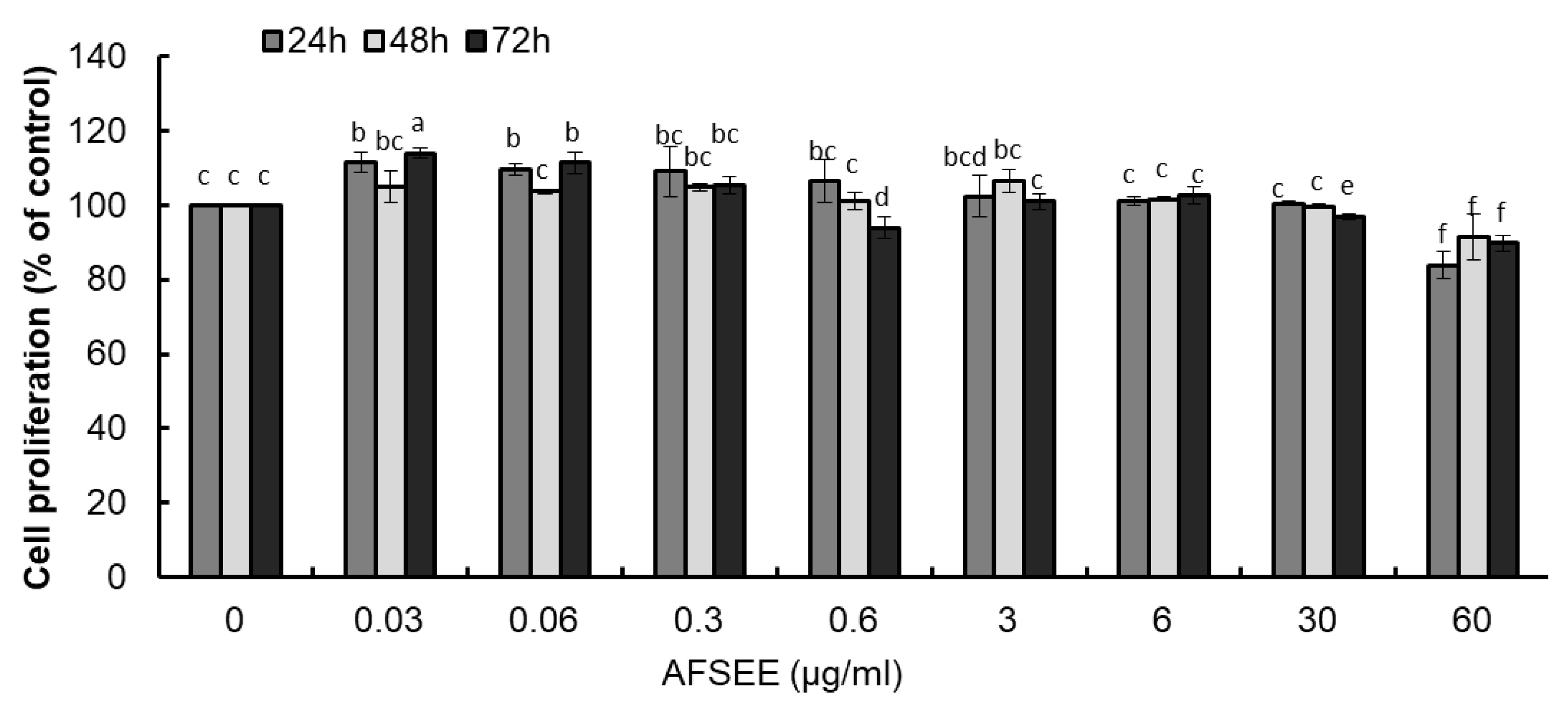
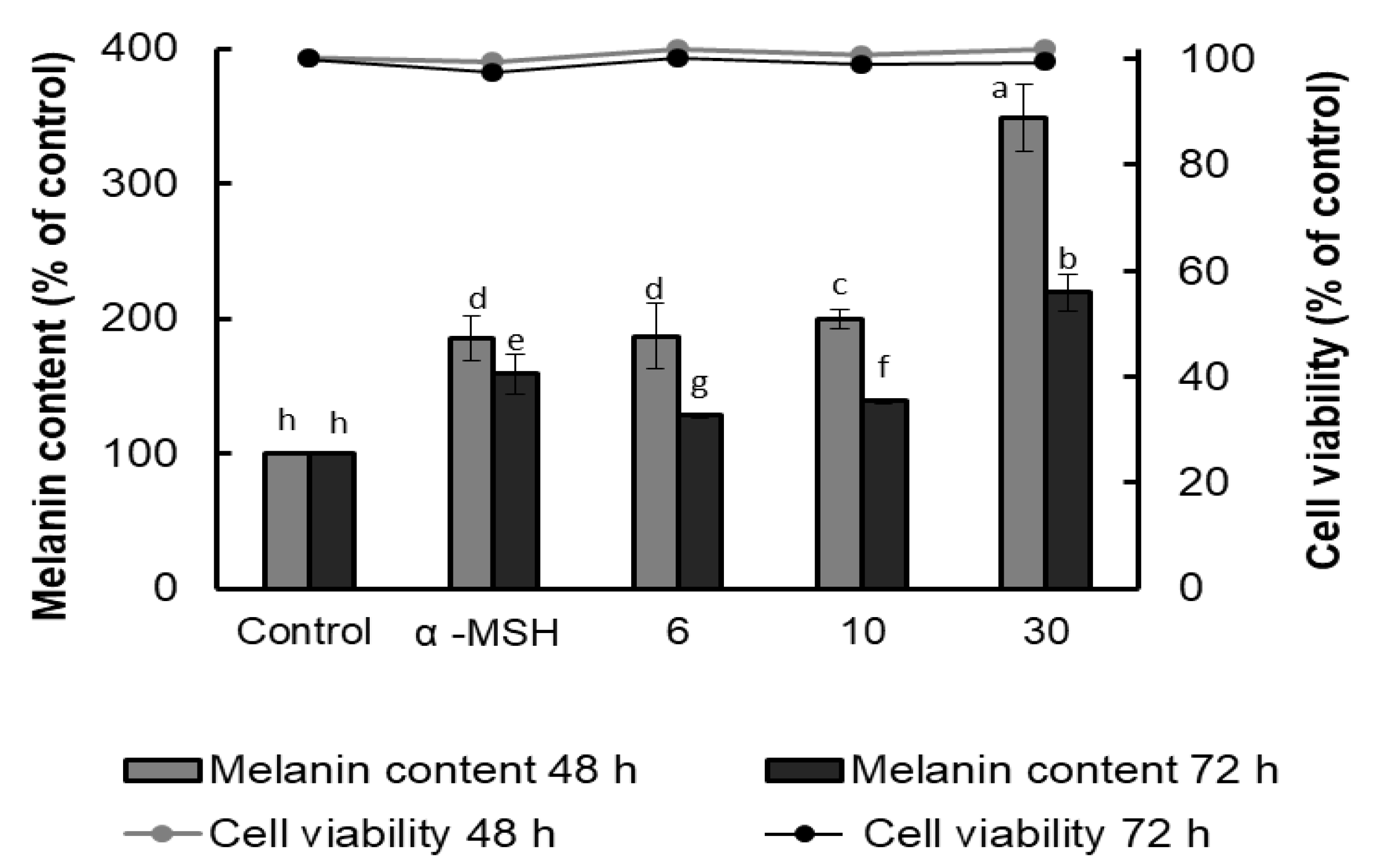


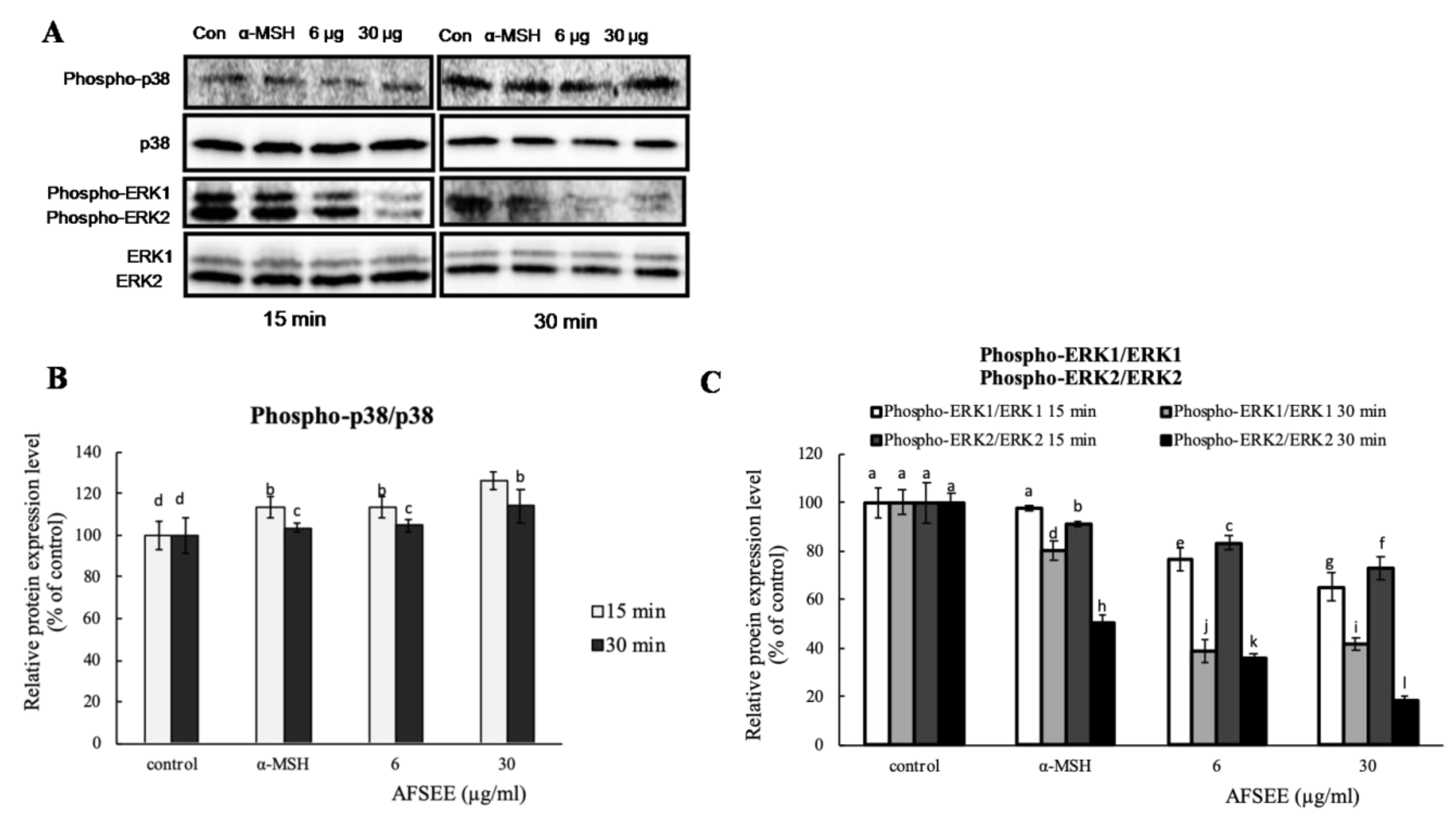
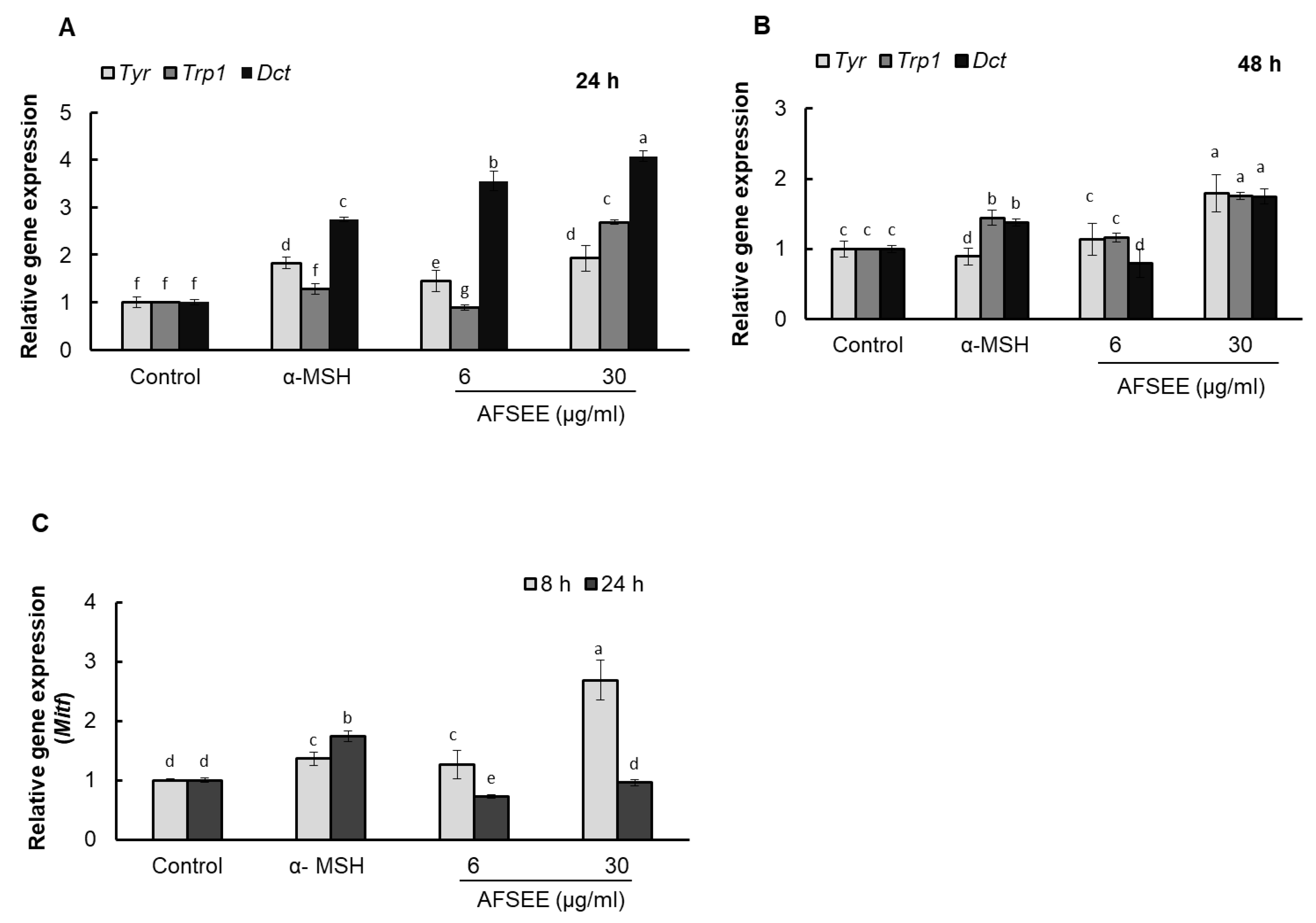

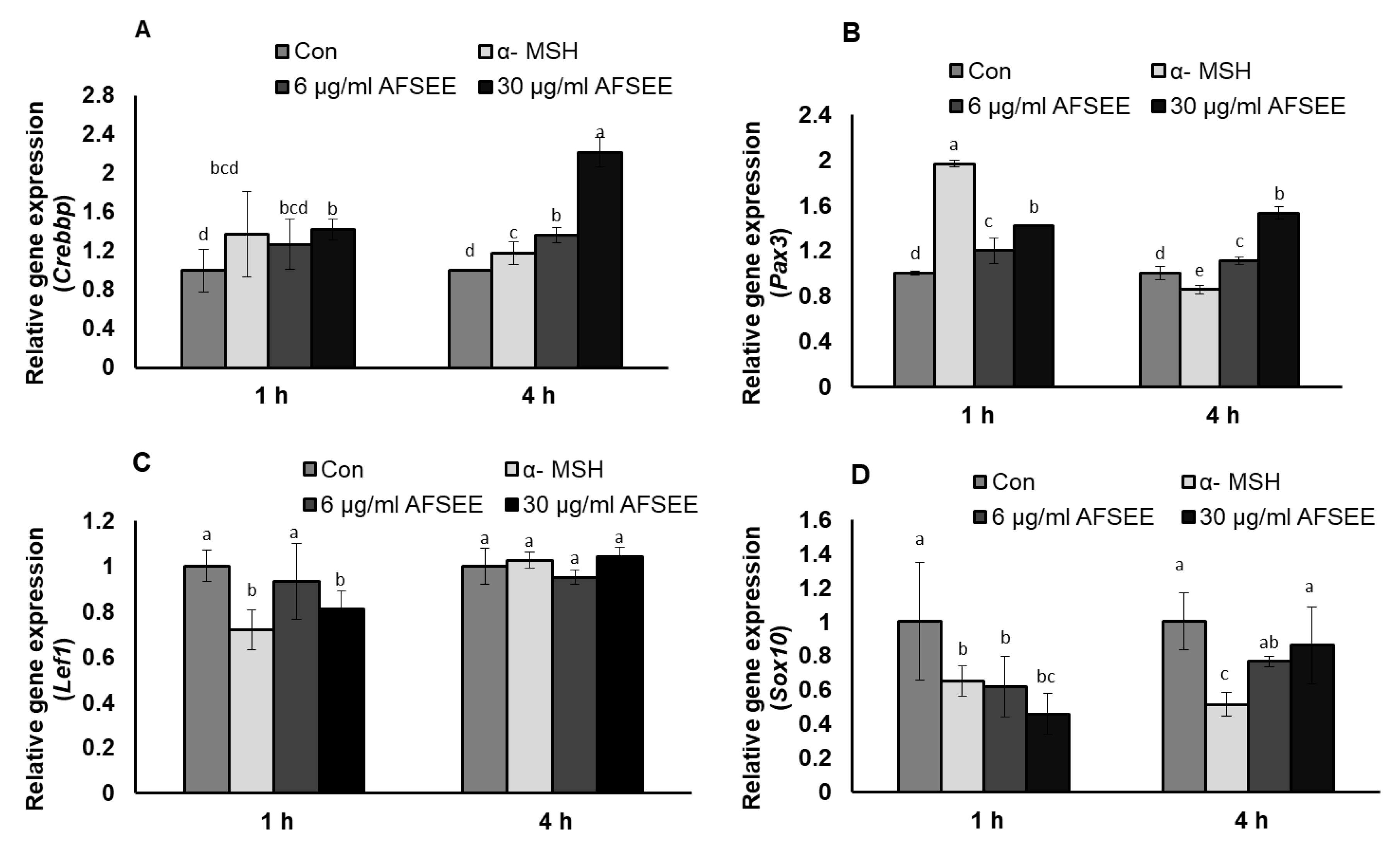
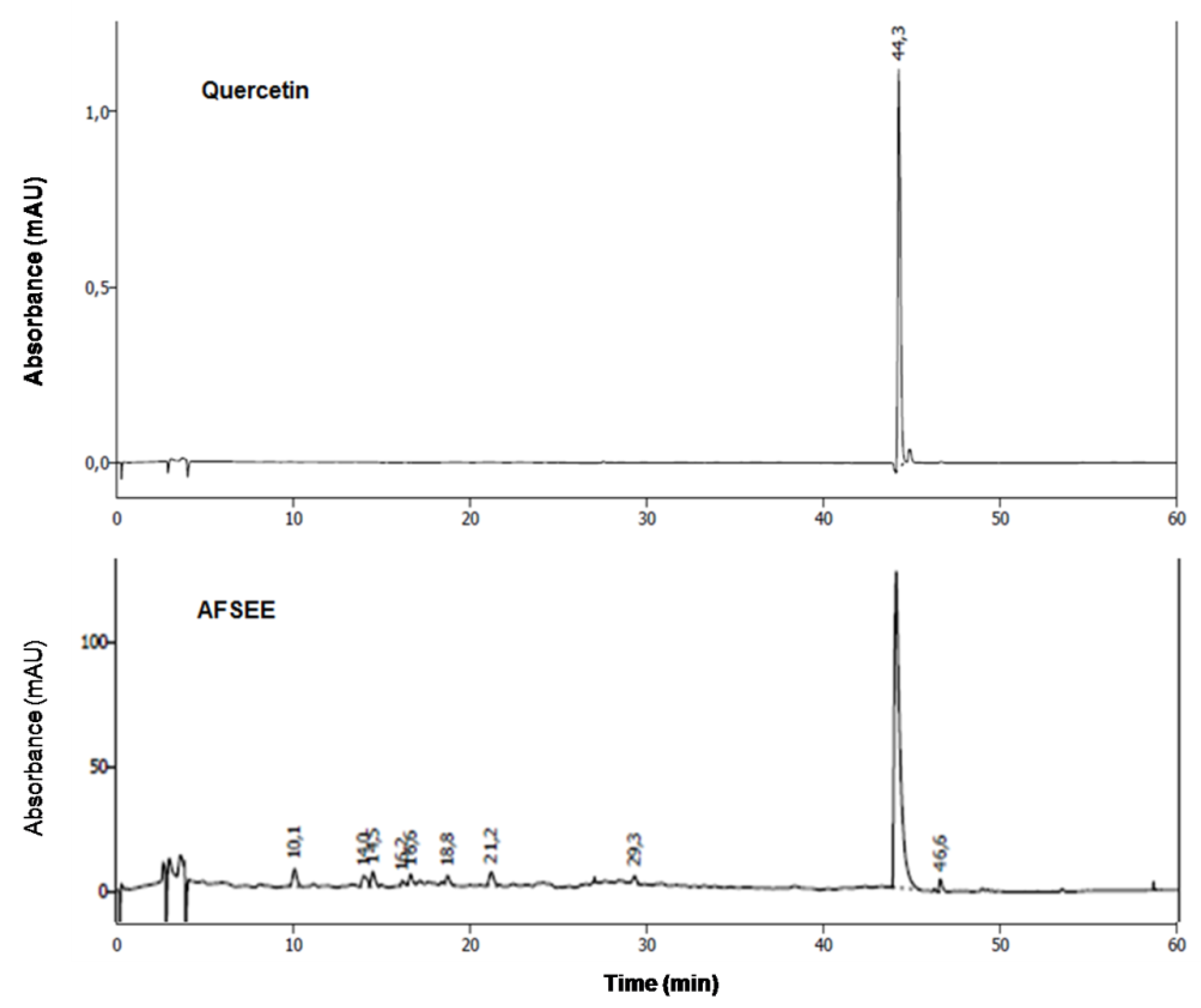
| Gene Symbol | Gene Title | Biological Process | AFSEE 6 µg/mL | AFSEE 30 µg/mL |
|---|---|---|---|---|
| Prpf4b | PRP4 pre-mRNA processing factor 4 homolog B (yeast) | mRNA processing, protein phosphorylation, RNA splicing. | 2.5 | 5.8 |
| Ankrd10 | Ankyrin repeat domain 10 | Regulation of canonical Wnt signaling pathway. | 1.9 | 4.0 |
| Cenpe | Centromere protein E | Cell cycle, cell division, chromosome segregation, establishment of protein localization, positive regulation of protein kinase activity. | 1.7 | 3.6 |
| Atrx | Alpha thalassemia/mental retardation syndrome X-linked homolog (human) | Cellular response to DNA damage stimulus, signal transduction by p53 DNA repair, DNA replication-independent nucleosome assembly. | 1.9 | 3.4 |
| Akap13 | A kinase (PRKA) anchorprotein 13 | Nuclear export, regulation of cardiac muscle hypertrophy, regulation of glucocorticoid mediated signaling pathway, regulation of protein kinase activity. | 2.1 | 2.1 |
| Tpr | Translocated promoter region | Cellular response to interferon-alpha, MAPK import into nucleus, response to epidermal growth factor. | 1.2 | 2.1 |
| Cxcl10 | Chemokine (C–X–C motif) ligand 10 | Positive regulation of cAMP metabolic process, positive regulation of cAMP-mediated signaling, positive regulation of cell proliferation. | 1.2 | 2.0 |
| Hells | Helicase, lymphoid specific | Chromatin silencing, DNA methylation, mitotic nuclear division, multicellular organismal development. | 1.1 | 2.0 |
| Med1 | Mediator complex subunit 1 | Angiogenesis, keratinocyte differentiation, lactation-positive regulation of keratinocyte differentiation, ERK1 and ERK2 cascade, cellular response to epidermal growth factor stimulus, positive regulation of receptor activity, protein ubiquitination, positive regulation of protein import into nucleus, translocation. | 1.3 | 1.5 |
| Edaradd | EDAR (ectodysplasin-A receptor)-associated death domain | Cell differentiation | 1.1 | 1.5 |
| Jmjd6 | Jumonji domain containing 6 | Regulation of transcription, DNA-template, cell surface receptor signaling pathway. | 1.1 | 1.5 |
| Eed | Embryonic ectoderm development | Positive regulation of histone H3-K27 methylation, covalent chromatin modification. | 1.2 | 1.5 |
| Gnaq | Guanine nucleotide binding protein, alpha q polypeptide | Regulation of melanocyte differentiation, regulation of protein kinase activity, signal transduction. | 1.1 | 1.5 |
| Arcn1 | Archain 1 | Golgi vesicle transport, protein transport, vesicle-mediated transport. | 1.0 | 1.5 |
| Slc7a11 | Solute carrier family 7 member 11 | Amino acid transmembrane transport, response to toxic substance. | −1.3 | −1.8 |
| Gpr143 | G protein-coupled receptor 143 | Regulation of melanosome transport, regulation of melanosome organization. | −1.1 | −2.1 |
| Oca2 | Oculo-cutaneous albinism II | Melanocyte differentiation, cell proliferation, transmembrane transport. | −1.3 | −2.6 |
| Qualitative characterization | Parameters | Visual Detection |
| Alkaloids | - | |
| Flavonoids | +++ | |
| Saponins | ++ | |
| Coumarins | + | |
| Quantitative characterization | Parameters | Content in mg/g DW |
| Total polyphenols (mg gallic acid eq/g DW) | 22.11 ± 0.87 | |
| Total flavonoids (mg catechin eq/g DW) | 9.9 ± 0.2 | |
| Condensed tannins (mg catechin eq/g DW) | 1.60 ± 0.08 | |
| Saponins (mg oleanolic acid eq/g DW) | 16.23 ± 0.13 |
© 2020 by the authors. Licensee MDPI, Basel, Switzerland. This article is an open access article distributed under the terms and conditions of the Creative Commons Attribution (CC BY) license (http://creativecommons.org/licenses/by/4.0/).
Share and Cite
Makbal, R.; Villareal, M.O.; Gadhi, C.; Hafidi, A.; Isoda, H. Argania Spinosa Fruit Shell Extract-Induced Melanogenesis via cAMP Signaling Pathway Activation. Int. J. Mol. Sci. 2020, 21, 2539. https://doi.org/10.3390/ijms21072539
Makbal R, Villareal MO, Gadhi C, Hafidi A, Isoda H. Argania Spinosa Fruit Shell Extract-Induced Melanogenesis via cAMP Signaling Pathway Activation. International Journal of Molecular Sciences. 2020; 21(7):2539. https://doi.org/10.3390/ijms21072539
Chicago/Turabian StyleMakbal, Rachida, Myra O. Villareal, Chemseddoha Gadhi, Abdellatif Hafidi, and Hiroko Isoda. 2020. "Argania Spinosa Fruit Shell Extract-Induced Melanogenesis via cAMP Signaling Pathway Activation" International Journal of Molecular Sciences 21, no. 7: 2539. https://doi.org/10.3390/ijms21072539
APA StyleMakbal, R., Villareal, M. O., Gadhi, C., Hafidi, A., & Isoda, H. (2020). Argania Spinosa Fruit Shell Extract-Induced Melanogenesis via cAMP Signaling Pathway Activation. International Journal of Molecular Sciences, 21(7), 2539. https://doi.org/10.3390/ijms21072539




